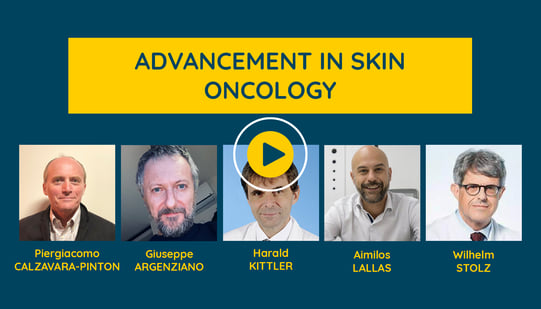5 professionals
International e-Symposium: Advancement in skin oncology (October 2022)
International e-Symposium: Advancement in skin oncology (October 2022)
URL copied
Access exclusive business services unlimited
Access valuable features : audio listening & tools sharing with your patients
Access more than 150 product sheets, dedicated to professionals
You already have an account ? login now
Speakers: Aimilios Lallas (Greece), Eduardo Nagore (Spain), Giuseppe Argenziano (Italy), Luc Thomas (France)
Moderator: Piergiacomo Calzavara Pinton (Italy)
Related topics
Although making a differential diagnosis can be challenging, presence of ulceration and white clods, on dermoscopy, entails the need for biopsy and excision, because of suspicion of SCC. Think of actinic cheilitis when seeing superficial erosions. If Wickham striae, hallmark of lichen planus white lines are present, the diagnosis is hypergranulosis. Finally, tumors rarely occupy the whole lip surface, while inflammations and infections do it much more frequently.

Aimilios Lallas is an Associate Professor of Dermatology at the First Department of Dermatology of Aristotle University in Thessaloniki, Greece.
He is specialized in skin cancer diagnosis with non-invasive techniques, as well as in the management of skin cancer patients.
His main field of research interest is dermoscopy of skin tumors, the application of the method in general dermatology and the improvement of the management of oncologic patients. He is an author of 363 scientific papers published on Pubmed Central, most of them on dermoscopy and skin cancer, and several books and book chapters on dermoscopy. The total number of citations of his papers exceeds 10.000 and his h-index is 49. He is a co-investigator in several Phase III Clinical trials on skin cancer treatment. He has been awarded several scholarships and scientific awards.
Over the last years, Dr Lallas has established scientific collaboration with numerous colleagues from several countries and supervised several fellows on skin cancer diagnosis and management. He is invited speaker in several domestic and international congresses and meetings, mainly on dermoscopy and on skin cancer diagnosis and management. He is particularly involved in teaching activities on dermoscopy, having organized and participated in numerous domestic and international courses.
Dr Lallas is currently the President of the International Dermoscopy Society.
There is a current and ongoing debate on the need for SLNB in melanoma. If adjuvant therapy is available and indicated regardless of SLNB status, SLNB can be avoided. In the meantime, decisions at this level, awaiting for consensus/guidelines, should be performed in institution committees and, most probably, case by case. The near future seems to aim at finding prognostic biomarkers (for risk of relapse and death) with many candidates currently under examination.

Dr. Eduardo Nagore is the Section Chief of the Melanoma Unit in the Department of Dermatology in the Instituto Valenciano de Oncología in València, Spain, since 2009 and a professor at the Universidad Católica de Valencia San Vicente Mártir since 2012. He is the Editor-in-Chief of Actas Dermosifiliográficas since 2018 and Associate Editor of several peer-reviewed journals, including Cancers (2019-present), Actas Dermosifiliográficas (2014-2018) and JEADV Clinical Practice.
He acted as a Board Member of the European Academy of Dermatology & Venereology (EADV) (2017-2021) and Member of the Scientific Programming Committee of the EADV (2018-present).
He was also the president of the 12th EADV Spring Symposium in València, Spain, 2015. He has lectured at several meetings of the Society for Melanoma Research, European Society for Pigment Cell Research, World Congress of Dermatology, EADV, European Academy of Dermato-Oncology & the Spanish Academy of Dermatology and Venereology.
Dr. Eduardo Nagore has authored or co-authored 319 scientific articles indexed in PubMed (H-index=34).
Since a clinico-pathologic discussion is possible only if images of the given lesion are available, an extensive clinico-dermoscopic documentation of all lesions undergoing excision and subsequent histopathologic examination should be considered.

Giuseppe Argenziano is Full Professor and Head of the Dermatology Unit at the University of Campania, Naples, Italy; Co-founder and past president of the International Dermoscopy Society; and Editor-in-Chief of Dermatology Practical and Conceptual Journal.
His main research field is dermato-oncology, being author of numerous scientific articles and books concerning dermoscopy, melanoma and non-melanoma skin cancer. As coordinator of the Melanoma Unit at the Campania University, he has established a successful tertiary, multidisciplinary, referral center particularly devoted to the diagnosis and management of patients with melanoma and non-melanoma skin cancer.
Over the past 25 years he has supervised over 500 foreign and Italian residents in Dermatology, established scientific collaborations with 1500+ colleagues from more than 50 Nations, and organized more than 500 national and international didactic meetings, courses, and conferences (such as the Consensus Net Meeting on Dermoscopy and the First Congress of the International Dermoscopy Society).
Professor Argenziano has authored more than 750 full scientific articles and produced landmark primary publications and books in the field of melanoma and dermoscopy. Over the past 25 years he has been invited as speaker and/or chairman in more than 500 national and international conferences in the field of dermatology. His combined publications have received a sum total of 19.000+ citations with an h-index value of 69 (Scopus 2022).
Both NUM and nail SSC require early diagnosis to avoid metastatic spread. Although there is no consensus, conservative treatment is a safe alternative to amputation in in situ or micro-invasive nail acral lentiginous melanoma and a safe alternative to amputation in nail SCC in the absence of bone involvement. However, a histopathologically free lower margin is required.
A fully conservative treatment of nail SCC can be proposed in selected cases (dominant thumbnail). While a threshold Breslow’s index of 0.5/0.7 mm is adopted by many experts, a higher Breslow’s index may be considered for specific cases (dominant thumbnail).

Luc Thomas, MD, PhD, was board certified in dermatology in 1989 at Lyon 1 University. He was trained as a post-doctoral fellow at Harvard Medical School in 1990 and 1991 and obtained his PhD degree at Lyon 1 University in 1993. He became full professor of dermatology in 1996, first class professor in dermatology in 2009, outstanding class professor in dermatology in 2015, and chairman of the department of dermatology of Lyon 1 University - Centre Hospitalier Lyon Sud in 2003. He obtained his board certification in clinical oncology in 2013
His main research fields include skin oncology, early diagnosis of melanoma, dermoscopy, skin surgery and nail diseases. He has published more than 500 peer-reviewed scientific articles in international journals, is the co-editor of four books published in several languages and co-author of more than 25 books. He has lectured at many international meetings, is a member of the executive board of the International Dermoscopy Society, a past member of the board and treasurer of the French Society of Dermatology.

Piergiacomo Calzavara Pinton, MD, PhD is Chairman of the School of Dermatology at the University of Brescia since 2004 & Chairman of the Department of Dermatology of the AO Spedali Civili di Brescia since 2003. He graduated in Medicine at the University of Milan in July 1980, magna cum laude. He completed School of Specialization in Dermatology at the University of Milan in July 1983. He is Full Professor of Dermatology at the University of Brescia since December 2015.
He participated at several Italian Ministerial projects (1990, 1991, 1992, 1993). From 2008 to 2012 he took part in the European Project V Framework Program for the Research and Technological Development of the European Union, entitled “Reflectance Confocal microscopy. From 2014 he is the referee of the Italian Ministery of University for the evaluation of the research in Dermatology.
He is the past president of Past President of the Italian Society of Dermatology (SIDEMAST) and Member of the Board of Directors of European Academy of Dermatology and Venereology (EADV); European Society of PhotoDermatology (ESPD); Italian Society of Photobiology (SIF); and Italian Group of Epidemiological Studies in Dermatology (GISED)
Since 1985 he practices research mainly in the field of Phototherapy, Photochemotherapy, Photodermatology, Psoriasis, Connective tissue diseases, Non-invasive diagnostic techniques, Skin tumours.
So far, Piergiacomo Calzavara-Pinton published 328 full papers on peer reviewed journals cited on PubMed, 354 on Scopus
55 chapters of book and over 200 abstracts in national and international congresses and conferences.



BIODERMA Congress Reports EADO 2023


BIODERMA Congress Reports EADO 2022



International e-Symposium: Advancement in skin oncology (October 2021)